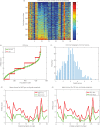Individual differences in schizophrenia
- PMID: 29163982
- PMCID: PMC5676076
- DOI: 10.1192/bjpo.bp.117.005058
Individual differences in schizophrenia
Abstract
Background: Whether there are distinct subtypes of schizophrenia is an important issue to advance understanding and treatment of schizophrenia.
Aims: To understand and treat individuals with schizophrenia, the aim was to advance understanding of differences between individuals, whether there are discrete subtypes, and how first-episode patients (FEP) may differ from multiple episode patients (MEP).
Method: These issues were analysed in 687 FEP and 1880 MEP with schizophrenia using the Positive and Negative Syndrome Scale for (PANSS) schizophrenia before and after antipsychotic medication for 6 weeks.
Results: The seven Negative Symptoms were correlated with each other and with P2 (conceptual disorganisation), G13 (disturbance of volition), and G7 (motor retardation). The main difference between individuals was in the cluster of seven negative symptoms, which had a continuous unimodal distribution. Medication decreased the PANSS scores for all the symptoms, which were similar in the FEP and MEP groups.
Conclusions: The negative symptoms are a major source of individual differences, and there are potential implications for treatment.
Declaration of interests: L.P. received speaker fees from Otsuka Canada and educational grant from Janssen Canada in 2017.
Copyright and usage: © The Royal College of Psychiatrists 2017. This is an open access article distributed under the terms of the Creative Commons Non-Commercial, No Derivatives (CC BY-NC-ND) license.
Figures




References
-
- Tsuang MT, Lyons MJ, Faraone SV. Heterogeneity of schizophrenia. Conceptual models and analytic strategies. Br J Psychiatry 1990; 156: 17–26. - PubMed
-
- Rolls ET. Cerebral Cortex: Principles of Operation. Oxford University Press, 2016.
-
- Rolls ET, Loh M, Deco G, Winterer G. Computational models of schizophrenia and dopamine modulation in the prefrontal cortex. Nat Rev Neurosci 2008; 9: 696–709. - PubMed
Grants and funding
LinkOut - more resources
Full Text Sources
Other Literature Sources
Research Materials

